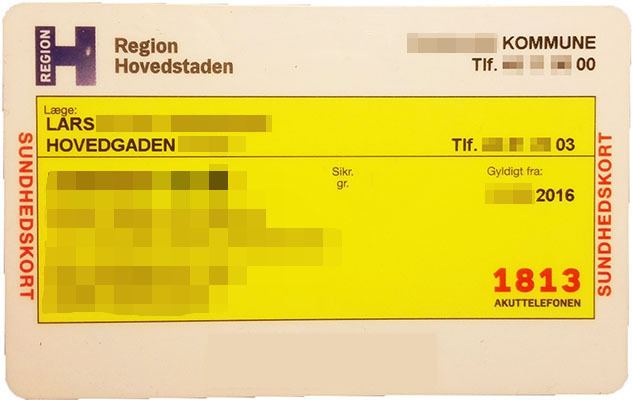 | ||
Healthcare in Denmark is largely financed through local (regional and municipal) taxation with integrated funding and provision of health care at the regional level.
Contents
Denmark spends 9.8% of GDP on healthcare. The life expectancy in Denmark is 78.6 years. There is 1 doctor for every 294 persons in Denmark.
Primary care
Most primary care in Denmark is provided by general practitioners, who are paid on a combined capitation and fee-for-service basis in a similar way to those in the United Kingdom. The regions determine the number and location of general practitioners, and their fees and working conditions are negotiated centrally between the physicians' union and the government. The municipal health services provide health visitors, home nurses and school health care.
Secondary care
Hospital care is mainly provided by hospitals owned and run by the regions (or the Copenhagen Hospital Corporation in the Copenhagen area). This is similar to the model in other Scandinavian countries.
There are few private hospital providers, and they account for less than 1% of hospital beds.
Central government
The central government plays a relatively limited role in health care in Denmark. Its main functions are to regulate, coordinate and provide advice and its main responsibilities are to establish goals for national health policy, determining national health legislation, formulating regulation, promoting cooperation between different health care actors, providing guidelines for the health sector, providing health and health care-related information, promoting quality and tackling patient complaints.
The Danish Quality Model, based on the Institute for Quality and Accreditation in Healthcare was introduced in 2005 and run in cooperation between Danish Regions, the Ministry of Health, Health Protection Agency, KL, the Danish Pharmaceutical Association and the Danish Chamber of Commerce. In April 2015 it was announced by Health Minister Nick Haekkerup and President of Danish Regions Bent Hansen that it was to be abandoned. Hansen said "“Quality work must be simplified and focused. The time has come to strengthen it by putting the patient at the centre, rather than focusing on compliance with a variety of standards. Accreditation has been justified and useful, but we move on. We need a few national targets to be met locally with strong commitment from the staff and with room for local solutions".
The financial stability law introduced in 2012 means that all regions and municipalities must keep within 1.5% of their budgets. The Central government must also now approve the introduction of new specialist facilities or the closure of existing facilities.
Local government
The 14 counties are responsible for hospitals and general practitioners. They are financed mainly through county income taxes.
The 275 local communes have long had responsibilities for nursing homes and care services. Local political accountability to a population with a large proportion of elderly people means that these services get political attention. The level of satisfaction with the health system in 1997 was greater than in other EU countries, including some with larger health care expenditures per capita. In 1988, legislation a law was passed limiting the construction of new nursing homes and nursing homes were converted to single-occupancy rooms. From 1997 all new housing for older people was required to have at least a bedroom, sitting room, kitchen, and bath.
The Skaevinge Municipality set up an Integrated Home Care project in 1984 which was evaluated by the Danish Institute of Health Care in 1997. Health care was made available to all citizens both in institutions and in their own homes and prevention and support to maintain and strengthen their health and quality of life were prioritised. They were involved in decision-making and the staff, working in small teams were given more autonomy. It was found that in 1997 40.8% of older people assessed their own health as good in comparison with 28.9% people of the same age in 1985. The number of days people over 67 spent in hospital fell by 30%. The nursing home was closed and became became a hub for community support services which included a senior center, day care, rehabilitation, 24-hour home care, and assisted living organised in three geographical teams. Nursing home staff were guaranteed jobs in the new set up. This integrated approach was widely adopted in Denmark. Nursing homes and home care organizations were no longer staffed separately. Between 1985 and 1997 the number of nursing home beds in Denmark was reduced by 30%.
eHealth
Denmark is one of the world's leading countries in the use of health care technology. Virtually all primary care physicians have electronic medical records with full clinical functionality. Practitioners use Electronic Medical Records (EMR) and Electronic Prescribing to exchange clinical messages (EDI) using the MedCom network. Despite the high adoption levels, the reality is that Denmark for several years has suffered from eHealth system fragmentation which has led to eHealth's inability to reach full potential in delivering quality healthcare service.
The Regions of South Denmark, Region North and Central Region Demark have implemented modern and coherent EMR's with a number modules. Larges coherent EMR installation is in the Central Region of Denmark. Solution is delivered by the Danish company Systematic. The solutions is run centralized and used on all 17 Hospitals of more than 20.000 users.
In an attempt to unify their fragmented e-health network, the Zealand regions will begin using a common EMR in 2016 - Epic. Epic is one of the world's leading healthcare IT companies and has experienced significant growth in recent years.
Performance
Denmark has made dramatic advances in the reduction of heart disease mortality according to the Euro health consumer index.
